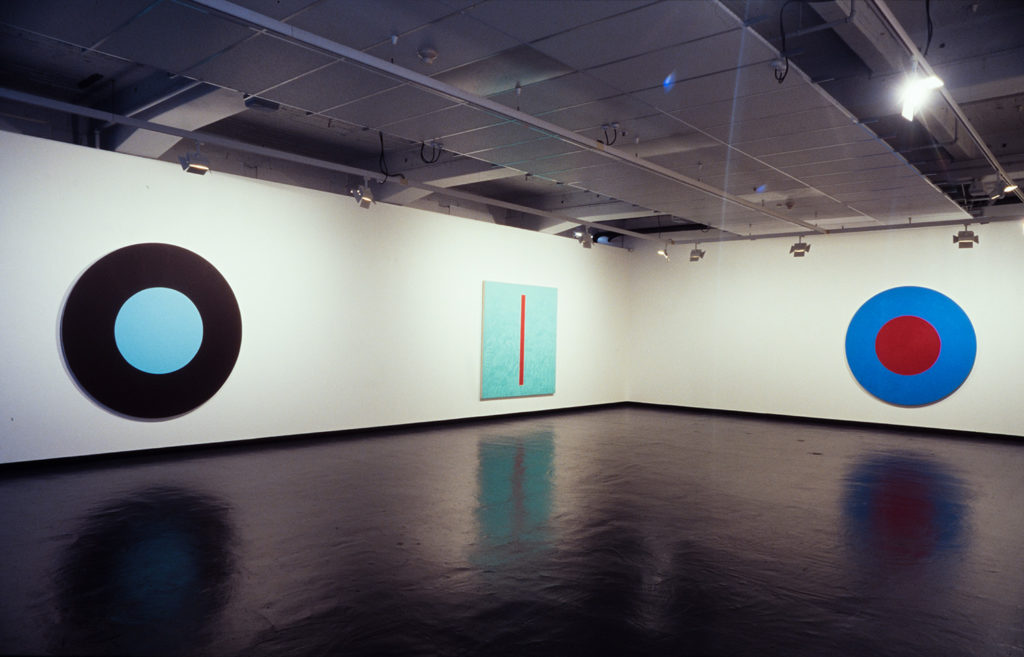CURATOR Wystan Curnow ORGANISER Auckland Art Gallery OTHER VENUES Auckland Art Gallery, 19 June–29 August 2004 SPONSOR Montana Wines PUBLICATION Essays Wystan Curnow, Thomas McEvilley
The Brush of All Things surveys the work of expat New York–based artist Max Gimblett, confirming his place as one of New Zealand’s leading abstract painters. He is important. ‘Max gives New Zealand a foothold in late modernist painting, because locally we don't have anyone who develops directly out of abstract expressionism’, says curator Wystan Curnow.
In the 1970s, alongside other New York painters like Joseph Marioni and Brice Marden, Gimblett is part of a move leading out of abstract expressionism towards monochrome painting. But, in the early 1980s, like Marden, Gimblett decides monochrome painting is too limiting, too doctrinaire, and goes back to the well of abstract expressionism to refurbish and rejuvenate his work, prompting an expansion in his work.
Gimblett’s work becomes rich, and inventive, with a wide technical and stylistic range. The monochrome, geometric abstraction, the calligraphic, and figurative expressionism all find a place in it. There sometimes appear to be many Gimbletts: one is an extroverted colourist, another pursues the subtle luminous effects of gilded and lacquered surfaces. Gimblett brushes with all things: sacredness and passion; violence, sacrifice, and death; fear and awe; beauty, pleasure, peace, and joy.
Gimblett is known for his novel shaped canvases. Their formats include circles, rings, ovals, and quatrefoils. The quatrefoil format—four intersecting circles connecting at a central point—features in Gothic and Renaissance art, but Gimblett makes it his own. The sharp geometry of Gimblett’s supports often operates in counterpoint to his expressive calligraphic painting, as in the quatrefoil Action Painting (2003), a homage to Jackson Pollock and the abstract expressionists of the 1940s and 1950s.
Entwining Eastern spirituality and modernism, Gimblett’s work can be understood in the context of ‘Western Buddhism’. He discovered Zen when living in San Francisco in the 1960s. He says: ‘The impulse is to feel. I paint without thinking, in an unconscious, free way.’ John Daly-Peoples says Gimblett’s work has ‘a sense of the instant when emotion is realised and intuition revealed’. However, Eastern influence goes back earlier. Gimblett recalls childhood visits to Auckland War Memorial Museum. ‘In the Asian gallery I experienced Buddhism and I saw Japanese and Chinese objects. They seemed to have the same power as Māoritanga. They seemed to have an equal intensity and reality for me.’
Despite having lived in New York for the past three decades, Gimblett continues to visit and exhibit regularly in New Zealand. He feels the pull of the Pacific Ocean, connecting him to his homeland. He says, ‘I think it’s magnetic, it’s mineral. When I’m in the plane on the way over, I feel like I’m being pulled down into Mother Pacific.’
The show includes a video of Gimblett painting, filmed at Elam School of Fine Arts at the University of Auckland. The Brush of All Things is presented as part of a trio of solo shows of senior artists, the others being of Melvin Day and Joanna Margaret Paul.
















































